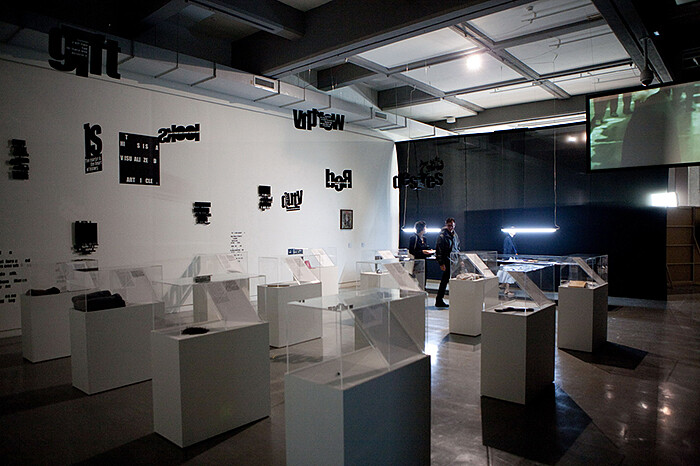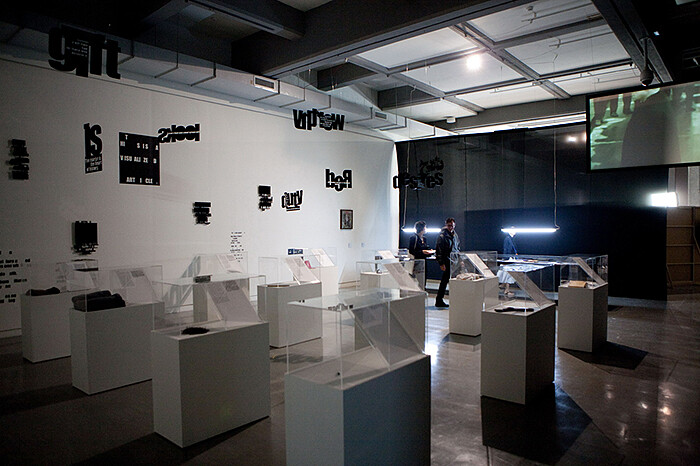“Modern Monster/Death and Life of Fiction”: Taipei Biennial 2012
September 29, 2012–January 1, 2013
“Reactivation”: The 9th Shanghai Biennale 2012
October 2, 2012–March 31, 2013
Anselm Franke, curator of the Taipei Biennial 2012, once remarked that art is a specialized language that shouldn’t be downplayed for popular appeal. True to his ideals, nearly all the works that filled the three-floor building of the Taipei Fine Arts Museum required a certain degree of intellectual engagement from the viewers, while offering little visual sensation. Nonetheless, it was a mesmerizing experience going through the entire exhibition, which contained so many vitrines and archival displays that it could have easily been mistaken for an ethnographical exhibition. Indeed, the exhibition was an in-depth study of a broad spectrum of human histories, both factual and fictional ones.
Citing Taiwanese art historian David Der-wei Wang’s book The Monster That Is History, in which history itself is compared to the ancient Chinese monster Taowu, Franke sought ways to give form to this indefinable being. He proposed that Taowu is “a possible common experience of all modernity.”
Hence, in the works of the 40-plus artists in the biennial, history is narrated, described, imagined, re-examined, recontextualized, recreated, and rewritten—the hybridity of this monster knows no bounds. The histories in question were either embodied in objects, figures, and events or in less tangible memories, emotions, and relations.
Taiwanese artist Yu-Cheng Chou’s Aurora (206 B.C.–220 A.D. /2012) took a group of pottery figurines, usually buried with the dead, from a collection of Chinese antiques and placed them in a modern vitrine under moving lights. The new context generated a different aura, rendering them less symbolic than purely aesthetic. Ghana-born, London-based artist John Akomfrah’s new work The Unfinished Conversation (2012) was a three-screen video installation constructing the multiple realities of Stuart Hall, a thinker who immigrated to the UK from Jamaica in the 1950s. In this complex and thought-provoking work, Akomfrah interwove Hall’s own voice and ideas with historical events of the 1950s and 1960s, giving weight to the notion that identity is neither a finished product or a given reality but rather an ever-changing relation between subjects and history.
Colonial culture is no doubt an indispensible chapter of modern history, a fact Franke certainly acknowledges and gives sufficient attention to in his exhibition. The results of the research Danish artist Joachim Koester made into the opium trade can be seen in Calcutta Served as a Basis for British Expansion in the East (2005–2007). Calcutta was the site where opium was auctioned off and shipped to China, yet traces of this trade are stunningly absent from local histories. Koester here pairs up a found image from a book along with an image that he took himself while in Calcutta; neither image makes direct reference to the specific history but rather bears remote evidence of the opulent life style of the city during this particular period. More directly didactic, however, was the work of New York-based German artist Andrea Geyer, who presented a lecture as the second chapter of her series “Spiral Lands” (2008). The room was transformed into a classroom while Geyer spoke about the subjectivity of the gaze, showing slides of empty Wild West landscapes in a loop.
A selection of mini-museums were realized in the biennial, becoming testimonies to both foreseeable and unexpected relationships among objects, imagery, documents, literature, and different means of creativity. The Museum of Ante-Memorials, the Museum of Crossings, the Museum of Gourd, the Museum of the Infrastructural Unconscious, the Museum of the Monster That Is History, and the Museum of Rhythm were curatorial projects organized by artists, curators, and art historians. Here is where we could see more objects, less archives, with each of the mini-museums creating a fiction narrated through its various artworks. The Museum of the Monster That Is History, for instance, was curated by James T. Hong and Anselm Franke. It showcased artistic projects, books, and (yet again) archival materials, alongside documentary footage by anonymous contributors, addressing the violence on which modern states and social orders have been founded. Each museum was conceived as a knowledge field and had a specific focus, be it the history of rhythm in the Museum of Rhythm (curated by Natasha Ginwala) or, in the case of the Museum of Ante-Memorials, it was the “relation of memorials to past and future, to actuality and possibility” (as curator Eric Baudelaire wrote). Such themes functioned as the connective tissue that brought different levels of realities and fictions into one context. The configuration of these museums runs parallel to that of the whole biennale, where works were shown next to each other through free associations and the subjective imagination of the curator.
Around the same time, rumors and speculations were running wild about the 9thShanghai Biennale, slated to open three days after Taipei. During its preparation, chief curator Qiu Zhijie (a Chinese artist) had been posting blogs and giving interviews announcing his grand ambition for the biennial. To begin with, the biennial, previously housed in the Shanghai Museum of Art, was now moved into Power Station of Art. The new building (originally a power plant and later the Pavilion of the Future for the World Expo 2010) had inspired the curator to harbor a greater vision for the show, which was to include international city pavilions in an effort to expand the scale. International curators came on board, such as Boris Groys and Jens Hoffmann as co-curators, setting expectations even higher; they were joined by a Shanghai Biennale repeat favorite, Hong Kong-based gallerist Johnson Chang Tsong-Zung. But one week prior to the opening, pictures of delayed construction and complaints from participating artists about disorganization and lack of responsiveness to their needs began surfacing all over weibo, a Chinese version of twitter. Qiu responded with an outrageous non mea culpa, pointing his finger instead at the shortage of funds and resources the organizer of the biennial had provided him with.
On the opening day, the exhibition appeared barely finished at all. Works were roughly installed, labels were misprinted, and, in many places, missing altogether. Wires dangled in the air and videos were still not working. Simon Fujiwara’s newly commissioned work, Rebekkah (2012), which consisted of 35 plaster cast pieces of a British girl, who had participated in a riot in England earlier in the year (and came with Fujiwara on a visit to the Terra Cotta site in Xi’an) was shown in the staircase. A couple of the pieces were broken; others were still wet. Fujiwara commented on the experience as being “beyond absurdity” and made the decision to do nothing but call it c’est la vie.
“Reactivation” was the overarching theme of the biennial, which the press release elaborated upon as “a metaphor, a declaration, responding to the reform and restarting of the building.” There were four subthemes: “Resources,” “Revisits,” “Reform,” and “Republic,” each of which was illustrated by a number of artists’ works. Yet these four themes had a less direct relation with the chosen works of the artists than with a desire to echo a kind of hollow optimism and promises that the government tries to dole out to the people. The list of the nearly 100 artists included some of the most active members of the art world today, such as Claire Fontaine, Tris Vonna-Michell, Ryan Gander, Wael Shawky, Simon Starling, and Danh Vo, among many established artists, including Thomas Hirschhorn, Huang Yong Ping, Martha Rosler, and Boris Mikhailov to name a few—but the organization of the biennial did them little justice. A few pieces of Danh Vo’s We The People, which is a reproduction of the Statue of Liberty, (2010–ongoing) were crowded out by installations of other artists, not to mention the large storage area of chairs stacked on top of one another on the same floor. Coherence, in general, was severely lacking throughout: the works looked like orphans, desperate in the immensity of such a large-scale exhibition.
During his speech at the opening ceremony, Qiu looked to the future, claiming that the Shanghai Biennale would be the best in the world… one day. One had the impression that he thought of himself as a martyr-like figure, paving the way for its future greatness. In a way, the Shanghai Biennale felt like a monstrous figure (to come back to the Taowu of Taipei): an ideological animal, mirroring some of the challenges and problems perturbing Chinese society today. It’s full of grandiose aspirations, but the means and mentality to make them real are astoundingly lacking. As the curators, organizers, and sponsors celebrated the opening, the artists and the unfinished works were left sadly unattended.












